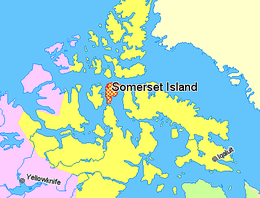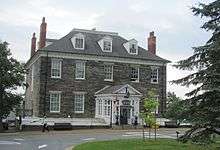Francis McClintock
| Sir Francis McClintock | |
|---|---|
_Leopold_McClintock_by_Stephen_Pearce_(2).jpg) Sir Francis McClintock c.1856 | |
| Born |
8 July 1819 Dundalk, County Louth |
| Died | 17 November 1907 (aged 88) |
| Allegiance |
|
| Service/ |
|
| Years of service | 1835–1884 |
| Rank | Admiral |
| Commands held | North America and West Indies Station |
| Awards | Knight Commander of the Order of the Bath |

Admiral Sir Francis Leopold McClintock[1] or Francis Leopold M'Clintock[2] KCB FRS (8 July 1819 – 17 November 1907) was an Irish explorer in the British Royal Navy who is known for his discoveries in the Canadian Arctic Archipelago. He discovered the fate of the Franklin Expedition and wrote an account of his own expedition to find it entitled The Voyage of the "Fox" in the Arctic Seas: A Narrative of the Fate of Sir John Franklin and His Companions.
Biography
Sir Francis Leopold McClintock was the eldest son of Henry McClintock, formerly of the 3rd Dragoon Guards, by his wife Elizabeth Melesina, daughter of the Ven. George Fleury, D.D., Archdeacon of Waterford.[3] His uncle was John McClintock (1770–1855) of Drumcar House. In 1835 McClintock became a member of the Royal Navy as a gentleman volunteer, and joined a series of searches for Sir John Franklin between 1848 and 1859. He mastered travelling by using human-hauled sleds, which remained the status quo in Royal Navy Arctic and Antarctic overland travel until the death of Captain Robert Falcon Scott RN in his bid to reach the South Pole. In 1848–49, McClintock accompanied James Clark Ross on his survey of Somerset Island. As part of Capt. Henry Kellett's expedition 1852 to 1854, McClintock travelled 1,400 miles by sled and discovered 800 miles of previously unknown coastline.[4]
In 1854 the explorer John Rae travelled west from Repulse Bay, Nunavut and learned from the Inuit that a ship had been abandoned somewhere to the west. Previous expeditions had not searched the area because they thought it was ice-blocked. In April 1857 Sir Francis Leopold McClintock agreed to take command of the Fox (177 tons, 25-man crew), which belonged to Lady Franklin, and search for her husband in the area west of Repulse Bay. At Disko Bay he hired 30 sled dogs and an Inuit driver. It was a bad year for ice and from September he was frozen in for eight months. 1858 was another bad year and he did not reach Beechey Island until August. He entered Peel Sound, found it blocked by ice, backed up, and entered Prince Regent Inlet in the hope of passing Bellot Strait. He was glad to extricate himself from this narrow passage and found winter quarters near its entrance. In February 1859, when sledging became practical, he went south to the North Magnetic Pole which had been found by James Clark Ross in 1831. Here he met some Inuit who told him that a ship had been crushed by ice off King William Island, the crew had landed safely and that some white people had starved to death on an island. In April he went south again and on the east coast of King William Island met other Inuit who sold him artefacts from Franklin's expedition. William Hobson, who had separated from him, found the only written record left by Franklin's expedition buried under a cairn on the northwest corner of the island (the document stated Franklin's date of death as June 11, 1847, and also intimated Francis Crozier and James Fitzjames' plan to lead the survivors south, towards mainland Canada). They also found a skeleton with European clothes and a ship's boat on runners containing two corpses. They got as far south as Montreal Island (Nunavut) and the mouth of the Back River. McClintock returned to England in September 1859 and was knighted. The officers and men of the Fox shared a £5,000 parliamentary reward. The tale was published in The Voyage of the 'Fox' in the Arctic Seas: A Narrative of the Discovery of the Fate of Sir John Franklin and His Companions. London, 1859.
McClintock's findings were of special importance for the subsequent romantification of John Franklin's figure in British culture, since the establishment of his date of death as having occurred before the ships' abandonment and the crew's failed trek south firmly acquitted the veteran sailor from any suspicion of cannibalism, which had been a concern since 1854, when John Rae had arrived in England with shocking reports from Inuit sources which had greatly scandalized Victorian society, particularly Lady Franklin. McClintock's writings, on the other hand, were obsequious towards Franklin, even going so far as to celebrate his "virtual completion" of the Northwest Passage, even though Erebus and Terror never sailed through Rae Strait, the only truly navigable passageway (with nineteenth-century ships) that would have allowed sailing along Canada's coast all the way to the Pacific.[5]
In 1872–1877 McClintock was Admiral-Superintendent of Portsmouth Dockyard.[6] In 1879 he was appointed Commander-in-Chief, North America and West Indies Station with the flagship HMS Northampton.[7] McClintock left the Royal Navy in 1884 as a Rear Admiral. He died on 17 November 1907.[8] He was buried in Kensington Cemetery, Hanwell, Middlesex.[9]
His son, Robert S. McClintock, married Mary, only daughter of Major-General Sir Howard Craufurd Elphinstone.[10]
On 29 October 2009 a special service of thanksgiving was held in the chapel at the Old Royal Naval College in Greenwich, to accompany the rededication of the national monument to Sir John Franklin there. It also marked the 150th anniversary of Sir Francis Leopold McClintock's voyage aboard the yacht Fox.[11]
Admiral Sir Frances Leopold McClintock has several portraits in the National Portrait Gallery, London.
Gallery
 Sir Francis McClintock
Sir Francis McClintock Cover of The Voyage of the 'Fox' in the Arctic Seas
Cover of The Voyage of the 'Fox' in the Arctic Seas McClintock's Travelling Party Discovering the Remains of Cairn at Cape Herschel - Walter W. May (1855)
McClintock's Travelling Party Discovering the Remains of Cairn at Cape Herschel - Walter W. May (1855) The 'Fox' on a Rock Near Buchan Island - Walter W. May (1855)
The 'Fox' on a Rock Near Buchan Island - Walter W. May (1855)
See also
- De Salis Bay
- M'Clintock Channel
- MacKlintok Island
- European and American voyages of scientific exploration
- O'Byrne, William Richard (1849). "


References
- ↑ Library and Archives Canada
- ↑ Princeton University
- ↑ Leonard George Carr Laughton (1912). "McClintock, Francis Leopold". Dictionary of National Biography. Retrieved 6 May 2015.
- ↑ Farley Mowat (1973), Ordeal by ice; the search for the Northwest Passage (The Fate of Franklin)
|format=requires|url=(help), Toronto: McClelland and Stewart Ltd, p. 288, OCLC 1391959 - ↑ 1947-, McGoogan, Kenneth, (2002). Fatal passage: the story of John Rae, the Arctic hero time forgot (1st Carroll & Graf ed.). New York: Carroll & Graf Publishers. ISBN 0786709936. OCLC 49226113.
- ↑ "M'CLINTOCK, Francis Leopold". Who's Who. Vol. 59. 1907. p. 1107.
- ↑ William Loney RN
- ↑ "Admiral McClintock Dead; British Officer Who Discovered Sir John Franklin's Fate". The New York Times. 18 November 1907. Retrieved 25 July 2010.
- ↑ Library and Archive catalogue Archived 26 July 2011 at the Wayback Machine. Royal Society
- ↑ "Sir Howard and Lady Elphinstone". Bagshot Village.
- ↑ Online blog of Service of Thanksgiving
Further reading
- Coleman, E. C. (2007). The Royal Navy and Polar exploration: from Franklin to Scott. Stroud: Tempus. (2007), The Royal Navy and Polar exploration, Stroud: Tempus, ISBN 0-7524-4207-4
- Murphy, D. (2004). The Arctic Fox: Francis Leopold McClintock, discoverer of the fate of Franklin. Wilton, Cork: Collins Press. (2004), The Arctic Fox: Francis Leopold McClintock, discoverer of the fate of Franklin, Toronto: Dundurn Press, ISBN 1-55002-523-6
External links
| Wikimedia Commons has media related to Francis Leopold McClintock. |
- Works by Francis Leopold McClintock at Project Gutenberg
- Works by or about Francis McClintock at Internet Archive
- Works by Francis McClintock at LibriVox (public domain audiobooks)

- Biography at the Dictionary of Canadian Biography Online
- Princeton Essay on McClintock
- British Library Essay on Northwest Passage
- Toronto Library – Search for the Northwest Passage
| Military offices | ||
|---|---|---|
| Preceded by Sir Edward Inglefield |
Commander-in-Chief, North America and West Indies Station 1879–1882 |
Succeeded by Sir John Commerell |